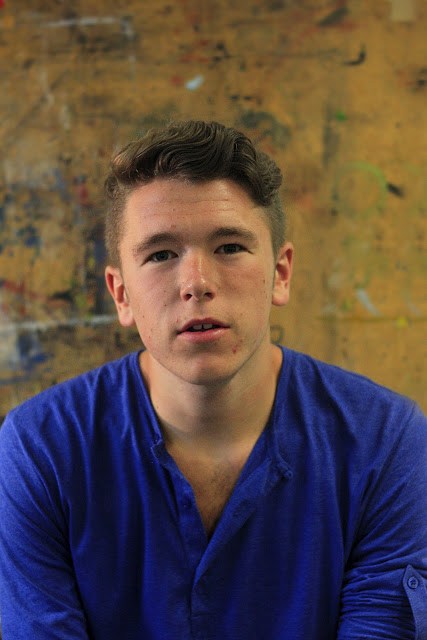Sunday, 7 October 2012
Friday, 5 October 2012
Post-Impressionism and I - Part Two of Three (Edouard Vuillard & Les Nabis)
Edouard Vuillard
Woman in a Striped Dress, 1895
Edouard Vuillard was a French painter and printmaker associated with the Nabis - an avante-garde subdivision of Post-Impressionism which formed in the 1890's, comprised of a group of art students inspired by the synthetism of Gauguin. Vuillard contributed to their exhibitions at the Gallery of Le Barc de Boutteville, and later shared a studio with fellow Nabis Pierre Bonnard (coming up in Part Three!) and Maurice Denis. Brief Summary of Les Nabis
Les Nabis artists worked in a variety of media, using oils on both canvas and cardboard, distemper on canvas and wall decoration, and also produced posters, prints, book illustration, textiles and furniture. Considered to be on the cutting edge of modern art during their early period, their subject matter was representational (though often symbolist in inspiration), but was design oriented along the lines of the Japanese prints they so admired, and art nouveau. Unlike those types however, the artists of this circle were highly influenced by the paintings of the impressionists, and thus while sharing the flatness, page layout and negative space of art nouveau and other decorative modes, much of Nabis art has a painterly, non-realistic look, with color palettes often reminding one of Cézanne and Gauguin. Bonnard's posters and lithographs are more firmly in the art nouveau, or Toulouse-Lautrec manner
Good Summary of Vuillard's Style
In his paintings and decorative pieces Vuillard depicted mostly interiors, streets and gardens. Marked by a gentle humor, they are executed in the delicate range of soft, blurred colors characteristic of his art. Living with his mother, a dressmaker, until the age of sixty, Vuillard was very familiar with interior and domestic spaces. Much of his art reflected this influence, largely decorative and often depicting very intricate patterns.
I love Vuillard's dappled, painterly texture and restrained colour palette. His work on interiors is of particular interest to me, and combined with my exploration of the work of his British counter-part, Walter Sickert, will provide a good wealth of reference and inspiration to execute my painting of my parents in an interior setting.
Interieur, 1902
Breakfast, 1894
Madame Vuillard Sewing, 1895
A great source of Vuillard's interior paintings:
Wednesday, 3 October 2012
Post-Impressionism and I - Part One of Three (Introduction & Toulouse-Lautrec)
An influence so perfectly suited, a train of thought so wonderfully convoluted, resulting in blog post so monumental as to be torn triply asunder.
Introduction
'Post-Impressionism': a movement labelled with the vaguest of definitions, encompassing such a vast array of styles and deviations which just so happened to follow and draw inspiration from the vastly influential movement of Impressionism. The term describes the development of French art since 1886 (according to art historian John Rewald, although any concrete chronological, stylistic or geographical definition of the movement is contentious) The term 'Post-Impressionism' encompassed many separate but inter-related movements such as Pointillism, Cloisonnism and Sythetism. Leading figures of the movement were Van Gogh, Gauguin, Seurat, Cezanne and Toulouse-Lautrec.Currently, my attention is drawn to the work of Henri de Toulouse-Lautrec, Edouard Vuillard and Pierre Bonnard - a devastating three way tussle for the title of 'most Frenchified name'. The technical elements of Impressionism which so appeal to me (thick application of paint, high colour-vibration, distinctive brushstrokes and real, observational subject matter) are all still inherent in the particular facets of Post-Impressionism which they represent, yet there the stronger geometrical emphasis and more solid composition of the style also appeals to me.
Henri de Toulouse-Lautrec
In Bed, 1893
In this painting, Toulouse-Lautred shows two women sharing a bed together, although without any overt sexual suggestions. The bond seems fraternal rather than sexual, merely two people sheltering together from a harsh and demmanding world
Henri de Toulouse-Lautrec's artwork is intrinsically connected with his famous lifestyle. A debauched, alcoholic, aristocratic dwarf, Toulouse-Lautrec lived in the fashionable bohemian Paris neighbourhood of Montmatre, a town which in the late 19th century could turn a bishop into a drunkard, lustful mess in thirty minutes flat. Much of T-L's work focuses on the emergent Parisian nightlife as its subject matter, but despite the surface bawdiness and debauchery, I love the way that in his depictions of hungover prostitutes, exhausted cabaret dancers and closing bars, manages to treat his subject matter with a sensitivity, melancholy and tenderness that penetrates the contemporaneous reflection of the subjects and instead uses it as a subtext for a exploration of the very trembling core of what it means to be alive, living - a human being.
The Kiss
The Hangover" (Portrait of Suzanne Valadon), c.1888
A Corner of the Moulin de la Galette, 1892
Labels:
art,
brushwork,
colour,
Edouard Vuillard,
hangover,
Henri de Toulouse-Lautrec,
Impressionism,
kiss,
Montmatre,
nightlife,
observation,
painting,
Paris,
Pierre Bonnard,
post-impressionism,
thick paint
Tuesday, 2 October 2012
A Short Note to Self:
- Explore work of Gauguin, Seurat, Cezanne (& Van Gogh?) for better understanding of Post-Impressionism.
- Also, examine relationship with Much/Expressionsim? IS THERE ONE?
- Don Bachardy
Wednesday, 29 August 2012
Links To Helpful Bits of The Internet
Stuff on Sickert:
John Singer-Sargent:
Metropolitan Museum (largest JSS collection anywhere) masses and masses of images, loads of sketches
Degas:
Met Museum thematic essay
Munch:
Guardian article on Tate Munch exhibition
- http://www.tate.org.uk/art/artists/walter-richard-sickert-1941
- http://www.bbc.co.uk/arts/yourpaintings/artists/walter-richard-sickert/paintings/slideshow#/22
John Singer-Sargent:
Metropolitan Museum (largest JSS collection anywhere) masses and masses of images, loads of sketches
Degas:
Met Museum thematic essay
Munch:
Guardian article on Tate Munch exhibition
Subscribe to:
Comments (Atom)




















